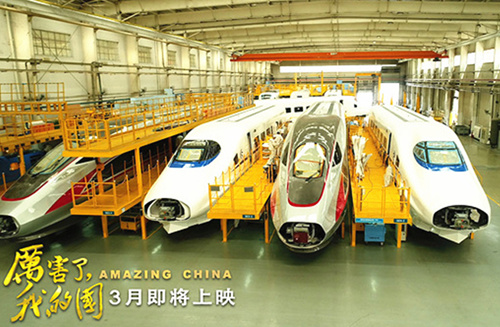
. > WHAT'S NEW > CONFERENCES
Domestic media integration a boon for documentary industry
Author : YU FAN Source : Chinese Social Sciences Today 2018-05-24

Pictured above is a poster for Amazing China, a documentary recording China’s achievements over the last five years. It has been the country’s all-time highest-grossing documentary so far. (CHINA DAILY)
A forum on the Chinese documentary industry was recently held in Beijing by the Documentary Research Center at Beijing Normal University, International Communication Center and leading video streamer Bilibili. The attendees examined the industry and its communication from a global perspective. Under this framework, they discussed the tendency of Chinese documentary filmmaking with an emphasis on communication and branding.
The 2018 Research Report on the Development of Chinese Documentary was released at the forum, offering a review of the sector in the year 2017. It showed that the total investment in Chinese documentary production in 2017 totaled 3.95 billion yuan and the annual output exceeded 6 billion yuan, a growth of 14 percent and 15 percent respectively. Compared to 2016, production input from television centers, private companies and new media groups all increased. The growth of new media investment hit 50 percent. Professional documentary channels and local channels play a part in the Chinese documentary sector, while new media groups support the advancement of the field, according to the report.
Zhang Tongdao, director of the Documentary Research Center at Beijing Normal University, outlined the main characteristics of the last year’s development in the sector in terms of creation orientation and communication access. He found documentary programs have cut an innovative path through a combination of recording and culture. The content has been diversified from an emphasis on cultural themes to a focus on reality. Also, the forms of these documentary programs tend to integrate with entertainment and stories. “Marketization has been the focal point of professional documentary channels in recent years, while branding is a new challenge for us under current circumstances,” Zhang said.
The constant development of the online video industry and a greater tendency for paid video products have driven new media to be a central platform for the documentary sector. New media has sustainably promoted the content innovation of documentary programs. Gan Chao, director of the documentary channel of Shanghai Television Station, said that documentary production and communication have undergone a broad range of transformations in 2017. In particular, programs disseminate themselves by relying on their quality content and the influence of television stations, whereas social media platforms and video streaming websites are now involved, serving as diverse communication channels. The documentary market is dramatically changing, attracting greater interest from users and capital, Gan added.
TV documentaries are embracing new media. Many new media platforms like video-streaming websites have joined the trend as well. The scale of active users of iQiyi, Tencent Video and Youku topped the domestic sector in 2017, according to the report. The new-media documentary sector develops by honing intellectual property (IP). Unlike its previous meaning, IP here refers to the renowned and popular characters among viewers. Also, the expansion of the IP market is a tendency of the new-media documentary sector. Professionals consent that new media dissemination are broadening the imaginary scope for image industrialization in the context of media integration.
The sector witnessed massive growth. Particularly, documentary films have developed significantly due to expanding scale and surging box office. Forty-four documentary films were screened publicly in 2017, an increase of 51.7 percent, while 16 documentary films collectively achieved a total box office of 269 million yuan. Ten of them are made in China and their box office totaled 263 million yuan, a year-on-year growth of 237 percent.
(Edited and translated by MA YUHONG)
Ye Shengtao made Chinese fairy tales from a wilderness
Ye Shengtao (1894–1988) created the first collection of fairy tales in the history of Chinese children’s literature...
-
How northern ethnicities integrated into Chinese nation
2023-09-18
-
Mogao caves
2023-09-12
-
Mogao Grottoes as ‘a place of pilgrimage’
2023-09-12
-
Time-honored architectural traditions in China
2023-08-29
-
Disentangling the civilizational evolution of China
2023-08-28
-
AI ethics in science fiction
2023-08-23













 2011-2013 by www.cssn.cn. All Rights Reserved
2011-2013 by www.cssn.cn. All Rights Reserved